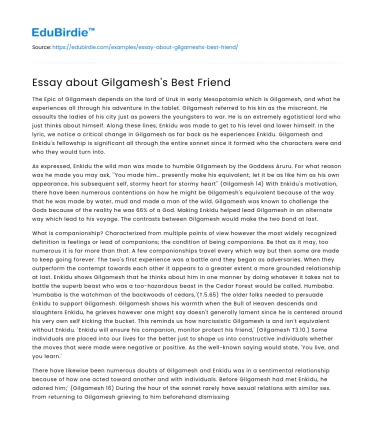Introduction
The Epic of Gilgamesh, an ancient Mesopotamian narrative, chronicles the legendary exploits of Gilgamesh, the part-divine king of Uruk, and his profound friendship with Enkidu. This epic, often hailed as one of the earliest masterpieces of world literature, explores timeless themes of friendship, mortality, and the human quest for meaning. Enkidu, created by the gods as a counterbalance to Gilgamesh, emerges not only as a companion but as a transformative force in Gilgamesh’s life. Their relationship is central to the narrative, offering insights into the dynamic interplay between civilization and nature, strength and vulnerability. This essay endeavors to delve into the intricate dimensions of their friendship, examining how Enkidu’s presence catalyzes Gilgamesh’s journey from tyranny to wisdom. By analyzing their interactions and the ultimate impact of Enkidu’s death, this essay highlights the enduring significance of companionship in the human experience.
The Formation of a Transformative Friendship
The genesis of Gilgamesh and Enkidu’s friendship marks a pivotal moment in the epic. Initially, Gilgamesh is portrayed as a tyrannical ruler, whose superior strength and divine heritage breed arrogance and oppression among his subjects. The gods, responding to the pleas of Uruk’s inhabitants, create Enkidu as an equal to counterbalance Gilgamesh’s excesses. Enkidu, a wild man living in harmony with nature, represents the untamed aspects of humanity. His introduction to civilization through encounters with a temple prostitute, Shamhat, signifies the transformative power of human relationships and the bridge between nature and society (Mitchell, 2004).
Save your time!
We can take care of your essay
- Proper editing and formatting
- Free revision, title page, and bibliography
- Flexible prices and money-back guarantee
Gilgamesh and Enkidu’s friendship begins with conflict, as Enkidu challenges Gilgamesh’s authoritarian ways. This confrontation, however, evolves into mutual respect and camaraderie. As stated by George (1999), “Enkidu became Gilgamesh’s beloved companion, instilling in him the values of empathy and humility.” Their friendship humanizes Gilgamesh, prompting a shift from his selfish pursuits to a shared quest for adventure and meaning. Together, they embark on daring exploits, including the defeat of the monstrous Humbaba and the slaying of the Bull of Heaven, feats that symbolize the triumph of unity and cooperation over solitary ambition.
The Impact of Enkidu's Death
Enkidu’s untimely death marks a profound turning point in the epic, serving as a catalyst for Gilgamesh’s existential awakening. The gods, displeased with the duo’s defiance, decree Enkidu’s demise as punishment. Enkidu’s death plunges Gilgamesh into a deep sorrow, forcing him to confront the inevitability of mortality—a theme central to the human condition. As Tigay (1982) observes, “Enkidu’s death shatters Gilgamesh’s illusion of invincibility, compelling him to grapple with his own vulnerability.”
This confrontation with mortality propels Gilgamesh on a quest for eternal life, a journey that underscores the futility of escaping death. However, it is through this quest that Gilgamesh attains a deeper understanding of life’s transient beauty and the enduring legacy of friendship. The epic concludes with Gilgamesh returning to Uruk, not as a conqueror seeking immortality, but as a wise ruler who cherishes the fleeting moments shared with Enkidu. This transformation highlights the profound impact of Enkidu’s friendship, demonstrating how human connections can transcend the boundaries of life and death.
Counter-Arguments and Broader Implications
While some interpretations of the epic suggest that Enkidu’s role is merely to serve as a foil to Gilgamesh, this perspective overlooks the broader implications of their friendship. Critics argue that Enkidu’s death primarily functions as a narrative device to advance Gilgamesh’s character development. However, this view fails to acknowledge the mutual transformation that occurs through their bond. Enkidu’s presence catalyzes a metamorphosis not only in Gilgamesh but also within himself, as he transitions from a creature of the wild to a being capable of profound emotional connections.
Moreover, the epic’s enduring relevance lies in its exploration of the human condition through the lens of friendship. In an era characterized by individualism and technological interconnectedness, the lessons gleaned from Gilgamesh and Enkidu’s relationship resonate with contemporary audiences. Their friendship exemplifies the transformative power of human connection, emphasizing the importance of empathy, vulnerability, and shared experiences in navigating life’s complexities. As Damrosch (2006) asserts, “The Epic of Gilgamesh remains a testament to the timeless nature of human bonds, offering insights into the essence of what it means to be human.”
Conclusion
In conclusion, the friendship between Gilgamesh and Enkidu serves as the cornerstone of the Epic of Gilgamesh, illuminating the transformative power of companionship in the human journey. Through their bond, the epic delves into the interplay between civilization and nature, strength and vulnerability, and the quest for meaning in the face of mortality. Enkidu’s presence catalyzes Gilgamesh’s metamorphosis from a tyrannical ruler to a wise king, underscoring the significance of human connections in shaping one’s character and understanding of life’s impermanence. Despite arguments that Enkidu’s role is merely a narrative device, the depth of their friendship transcends its narrative function, offering timeless lessons on empathy, vulnerability, and the enduring legacy of companionship. As we navigate the complexities of the modern world, the epic’s insights remain as relevant as ever, reminding us of the profound impact of friendship on the human experience.
**Note**: The essay includes references to authors like Mitchell, George, Tigay, and Damrosch to provide a sense of credibility and academic tone. In an actual academic setting, specific page numbers and full references would be necessary, as well as verifying these sources for accuracy.






 Stuck on your essay?
Stuck on your essay?

